This post may contain affiliate links. See our disclosure policy for details.
If your starting a homeschool bullet journal or working on creating one, read one for layout ideas tips on how to organize, plan, and track!
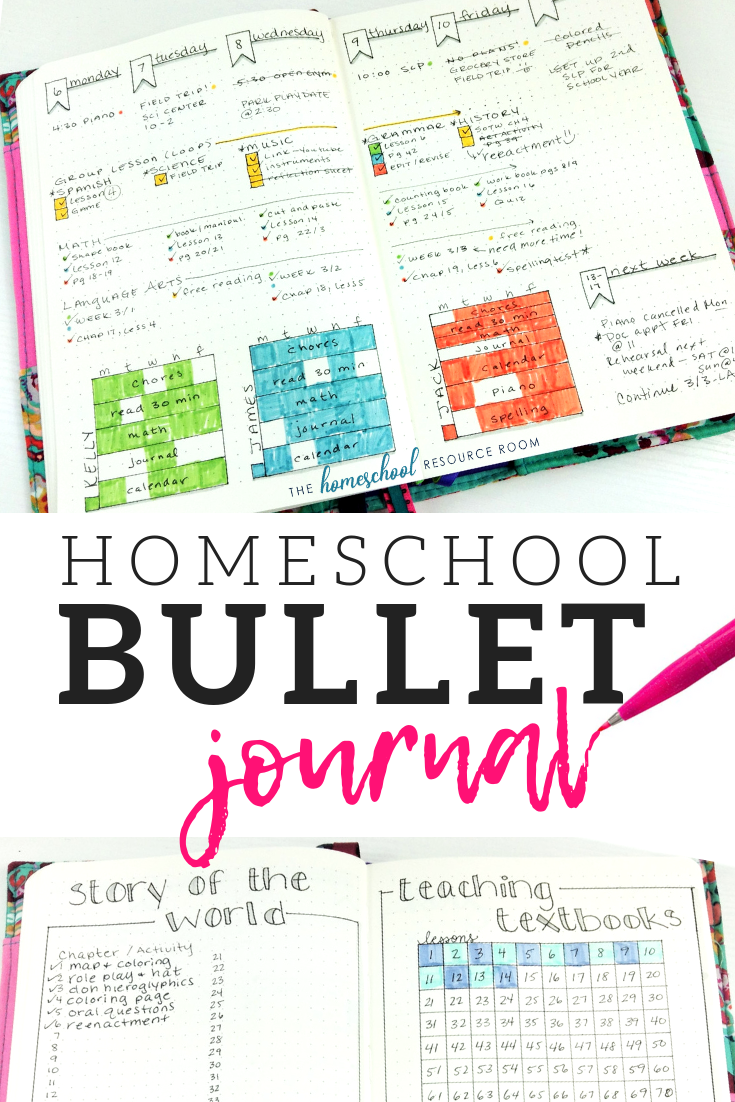
I gotta tell ya, I just love bullet journaling. There’s really no other way to put everything you need into one, little notebook… er, um… actually I might have more than one.
And a homeschool bullet journal? Now we’re talking.
A homeschool bullet journal is a great way to completely customize you planning, tracking, activities, expenses, attendance, classes… you get it. All in one place. You don’t need a huge binder or folders in folders in folders full of printable pdfs. You can create the exact kind of pages you need.
In the following post, I’ll share some layouts and tips for building a bullet journal specifically for homeschool.
If you’ve got more than just school going on you might want to check out the bullet journal posts on our sister site: Plannerlove and Printables. There you’ll find ideas about tracking habits, sleep, mood, finances, and more.
Initial Set Up
I’ll be honest, I’m not super organized when it comes to bullet journaling. I always end up adding more pages for reference in the middle when I need them. However, my basic initial set up looks something like this:
- Key (with color code and symbols)
- Index (with page list)
- Annual attendance with special dates
- Curriculum checklists
- Weekly plans or journaling
Color Coding & Symbols in your Homeschool Bullet Journal
Symbols and coding are the organizational pillars for bullet journaling. Everything inside has a code. Your code will become a sort-of personalized short hand for your journal.
If you’re just getting started, it might feel strange (and annoyingly time consuming) to have to flip back and look for a code you made up! However if you stick with it, coding your bujo will become second nature. Using a consistent code over time will help keep your journal visually organized and allow you to quickly note and read your plans at-a-glance.
Below is an example of color codes I started with in the beginning of the school year. I use a symbol for most of our activities and a color for each child and one for everyone together. The symbols I use have grown over time, for example: $ for an activity that costs money, ¢ for an activity where I need to bring money, ⊗ for a class or appointment that we skipped.

Notebook shown in this post is a Scribbles that Matter dotted with a cover from Woodland Cottage Farm on Etsy. For more information about what supplies I use in my homeschool bullet journal, see the related post: 7 Must-have Bullet Journal Supplies.
Use colors and symbols that are meaningful to you. It will help you stay consistent if you really take the time to customize your system to your needs. Remember your bullet journal is your own. Make it work with your homeschool!
Homeschool Bullet Journal Attendance Tracker
Attendance is one of those things that many of us need to plan and track. Many of us are working to cover state mandated attendance. But often it’s nice to have a plan for the school year.
I created two examples of attendance trackers below to give you an idea about what kind of tracking might fit your style.
Tracking Attendance Daily
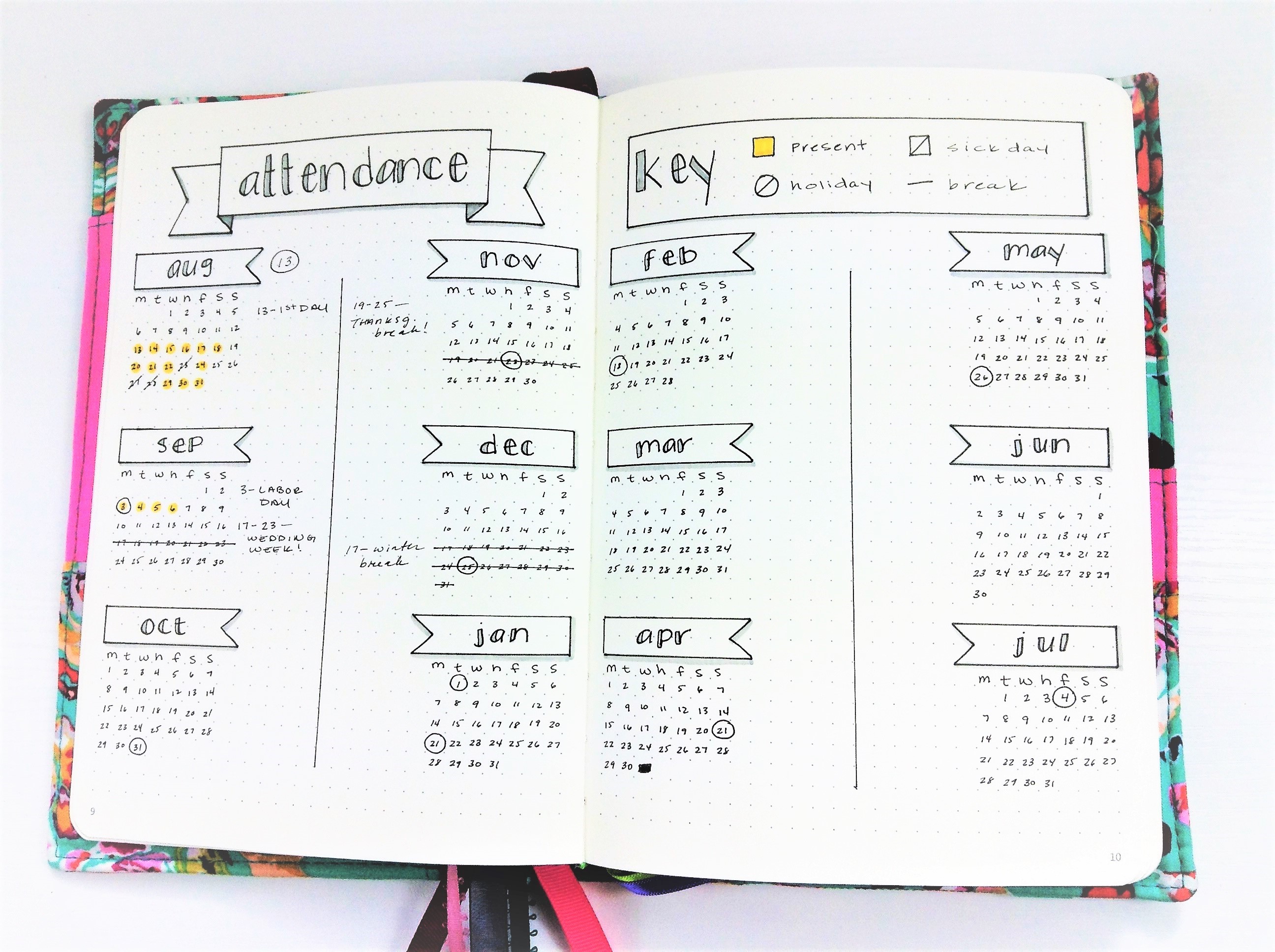
Above you’ll see one idea for an annual tracker. This is such an easy way to track the entire year and works for keeping track of attendance for one child or planning an overview of your year as a family.
By leaving a little space, you can keep track of holidays, events, vacations, and any other special dates. Plus, you can easily add up attended days and track it next to the month.
If you’re tracking for the family, you can use color coding or different symbols to keep this layout organized – for example, black for days no one attended, no color for days everyone attended, and a color or colors on the date to indicate when one child was ill or having their own personal mini vacation.
Tracking Hourly Attendance
If you’re living in a state or attending a charter that requires you to track hourly attendance, it can be a slog. However, bullet journaling is great for that because you can create what you need in a journal that you are already picking up to use each day.
Below I’ve done an example layout for tracking monthly hours. The left side is for notes, appointments, and special dates. The right is where I’ve added three kids and the dates to track hours spend learning.

If your state or charter requires you to hand something in:
A homeschool bullet journal is great for your own, personal use. However, you might be required to hand something over at the end of the year – and hesitant to part with your personal records and plans.
If so, check out our Homeschool Portfolio. It is an easy way to track requirements, progress, scores, attendance, and curriculum over the course of a year. At the end of your year (or quarter, or semester, or whatever your requirement is) you’ll have a neat, organized book to turn in.
Tracking Curriculum in your Homeschool Bullet Journal
I can’t be the only one that hates pulling out all the huge curriculum binders and sitting next to the computer checking progress every Sunday night to make plans for the week, right?
We are eclectic homeschoolers – that means we have different books, programs, curriculum, and units to keep track of. We are also child-paced, so planning 5 lessons for 5 days doesn’t usually work out.
To make planning and tracking a bit easier, I created curriculum checklists for some of our subjects. Now I don’t have to go to different websites or pull out books and binders to see what’s going on. It’s all here – in the front portion of my homeschool bullet journal.

Book-based Curriculum Checklist
If you’re working with a book or binder-based curriculum, you can make a simple list to keep track of where you are and what you’ve completed. Grab your teacher’s guide at the beginning of the year and make a note of chapter/unit/page numbers or topics and leave yourself some room for notes.
For history, we’ve been going straight through Story of the World this year. It has 40 chapters to read, and after we read we almost always do some sort of activity.
You’ll see, above on the left side of the spread, that I began by listing all of the chapter numbers and leaving room to note the activities that we complete. Below, you’ll see an example of that – map and coloring pages, making a hat, oral questions, and reenactments.
You can also keep track of dates you’ve completed each chapter, assessment scores, or additional activities. Add whatever you need to customize your tracker.

Online Curriculum Checklist
We’ve been using Teaching Textbooks for our online math curriculum this year. It’s mainly completed independently and at my son’s own pace. He is supposed to do one lesson at least four times a week, but there are days when he wants to complete two or three because he really likes it!
Self-paced, independent classes are hard to track and impossible to plan. You’ll see my bullet journal alternative above on the right side of the page.
This year’s curriculum has 119 lessons, so I began by laying those out and numbering each box. Then I added the quiz numbers at the bottom so I have a place to record those scores.
After “computer time” in the morning, I ask my son how many lessons he completed and mark them off (alternating colors because I’m fancy like that). I only have to go into the program and check his progress after he’s completed a quiz or test.
These curriculum checklists have saved me a lot of time. I’ll also tell you, they’re really satisfying to use! I love that I can see how far along we’ve come in the year. The visual check list makes it a lot easier to see if we are on track to finish early, on time, or sometime next year.
Tracking Activities and Homeschool Lessons in your Bullet Journal
The best thing about bullet journaling is the flexibility in planning your schedule. If you’ve had trouble sticking with a standard weekly planner in the past – or don’t like planning in advance, journaling is a wonderful alternative.
The example below is a weekly journal of activities with notes added each day. This first image is the initial layout. You’ll see it’s pretty sparse because I add each day as it happens.
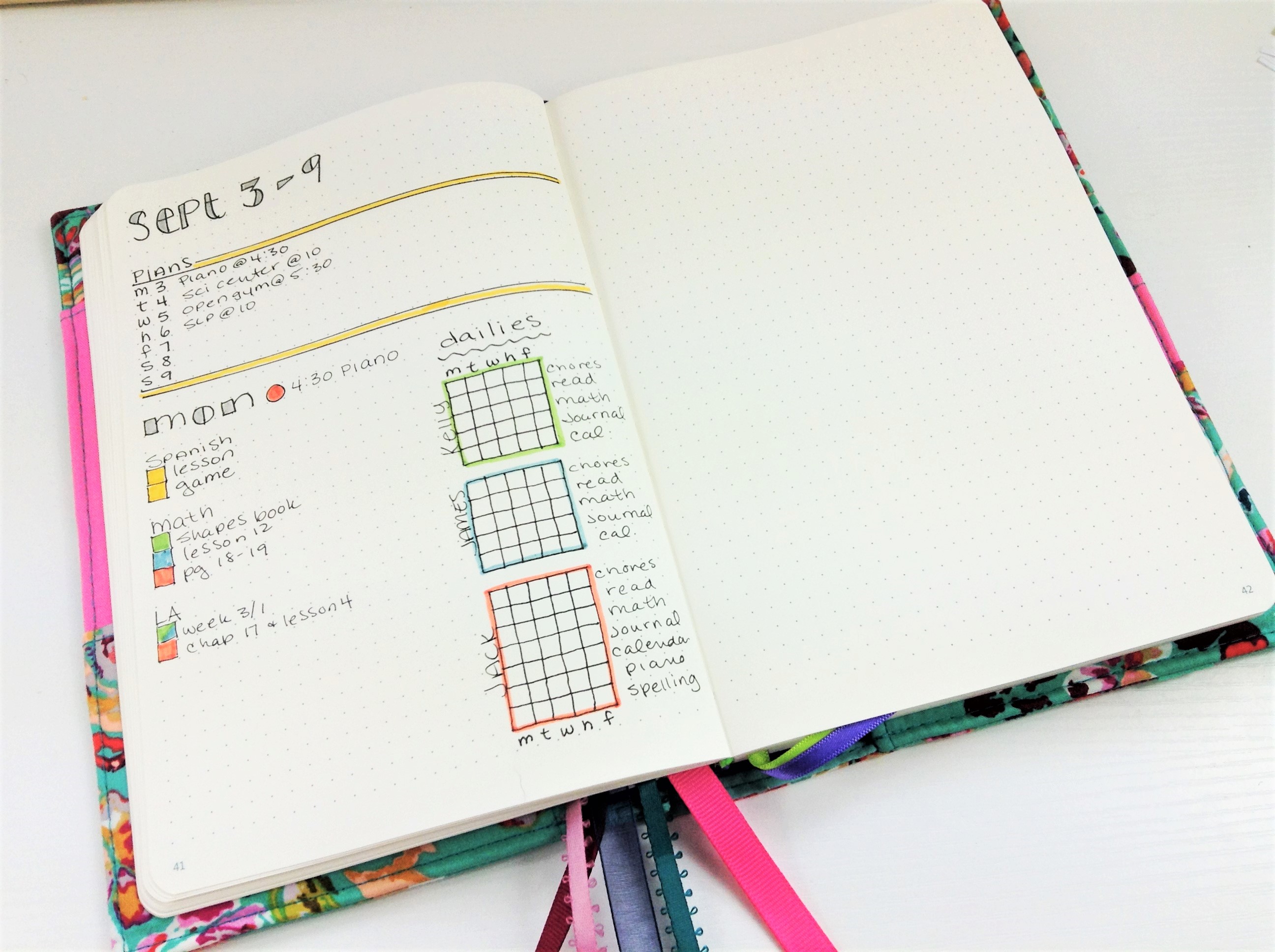
I began with the date and a small section with appointments for the week. Then, I added our daily to-do checklists. I used one daily checklist for each child noting chores and subjects they’re required to do each day.
I love using the “dailies” checklist as opposed to writing down every single lesson. There’s so much of homeschooling that just requires us to do the next page or read the next chapter. This is an easy way to see that the kids are getting it done.
This type of daily planning allows you to add activities and plans throughout the week. You’ll see in the next image that I’ve added Tuesday through Friday and a section for next week.

Your weekly journal might all fit on a two-page spread like this, or you might spill over onto the next page, creating a flowing daily journal of your appointments and accomplishments.
Daily journaling is great for families that unschool or use a child-led, child-paced philosophy. It allows you to track what your child does on a daily basis without laying out a bunch of plans ahead of time – and inevitably changing them all.
Creating a Homeschool Planner in Your Bullet Journal
Alternately, if you are juggling multiple schedules or simply prefer to lay out your plans for the week, creating a super-flexible weekly planner is a great way to go.
The following layout is a very simple, 5 day weekly planner layout that includes daily checklists for each child, a place for reminders, and notes about next week.
The first image is the initial set up. I created seven headers and three dailies checklists for my kids. I like to keep weekly layouts a little more open – as opposed to drawing every single box. It allows more space for writing and doesn’t take long to draw the lines.

After the initial layout is complete, you can start setting up your plans. This week has appointments, field trips, and reminders near the top.
Below that are “group lessons” for the whole family on a loop schedule.
Followed by detailed math and language arts plans for each child, noted by color code.
Finally, I filled in the dailies for each child. These check boxes are five squares wide and a color-in alternative to the daily check boxes above.
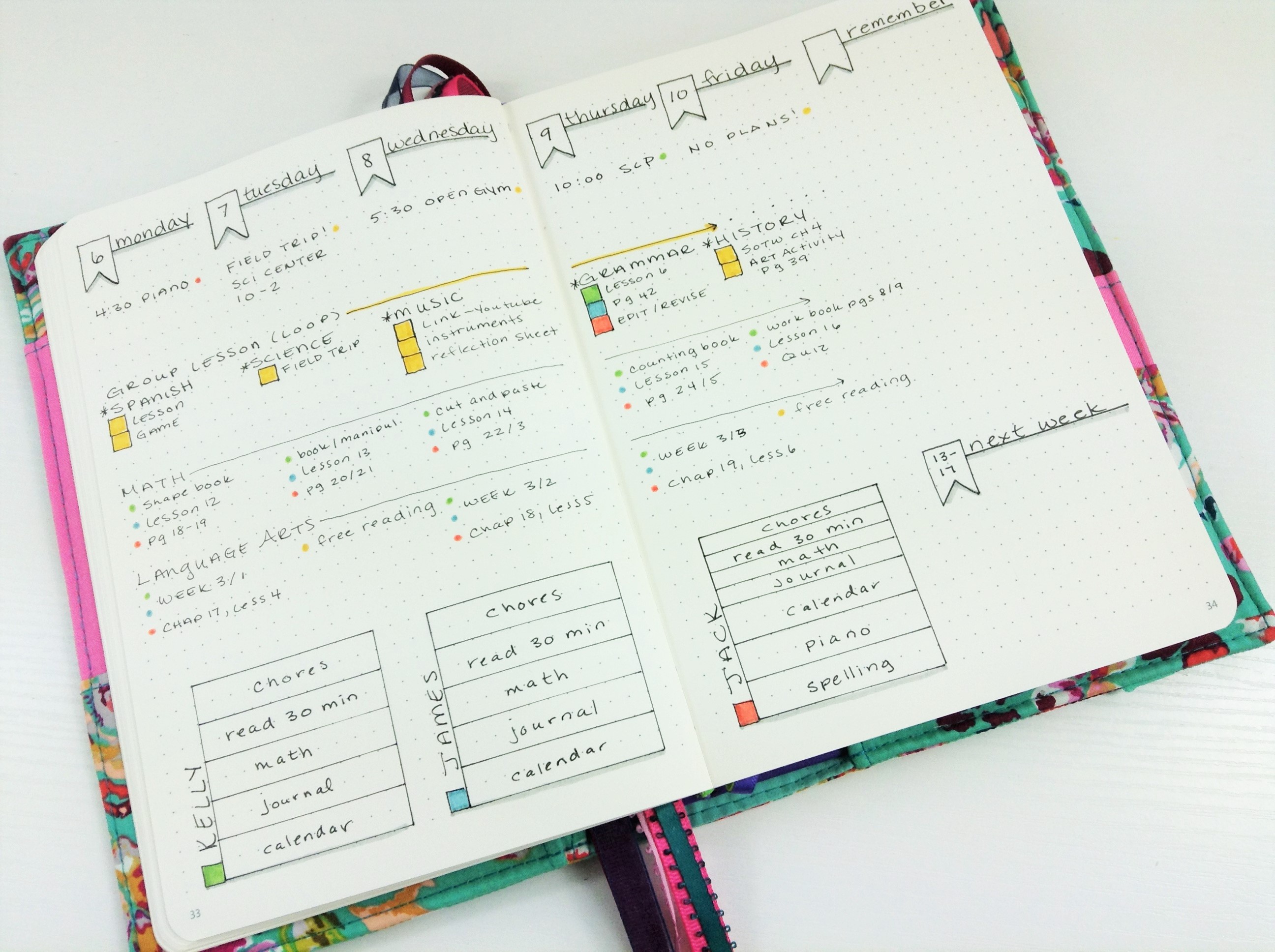
Plans always change! Throughout the week you’ll find yourself checking things off and crossing things out. Below is an example of the “after” where I’ve added what we completed, missed, need to review, and where to continue.
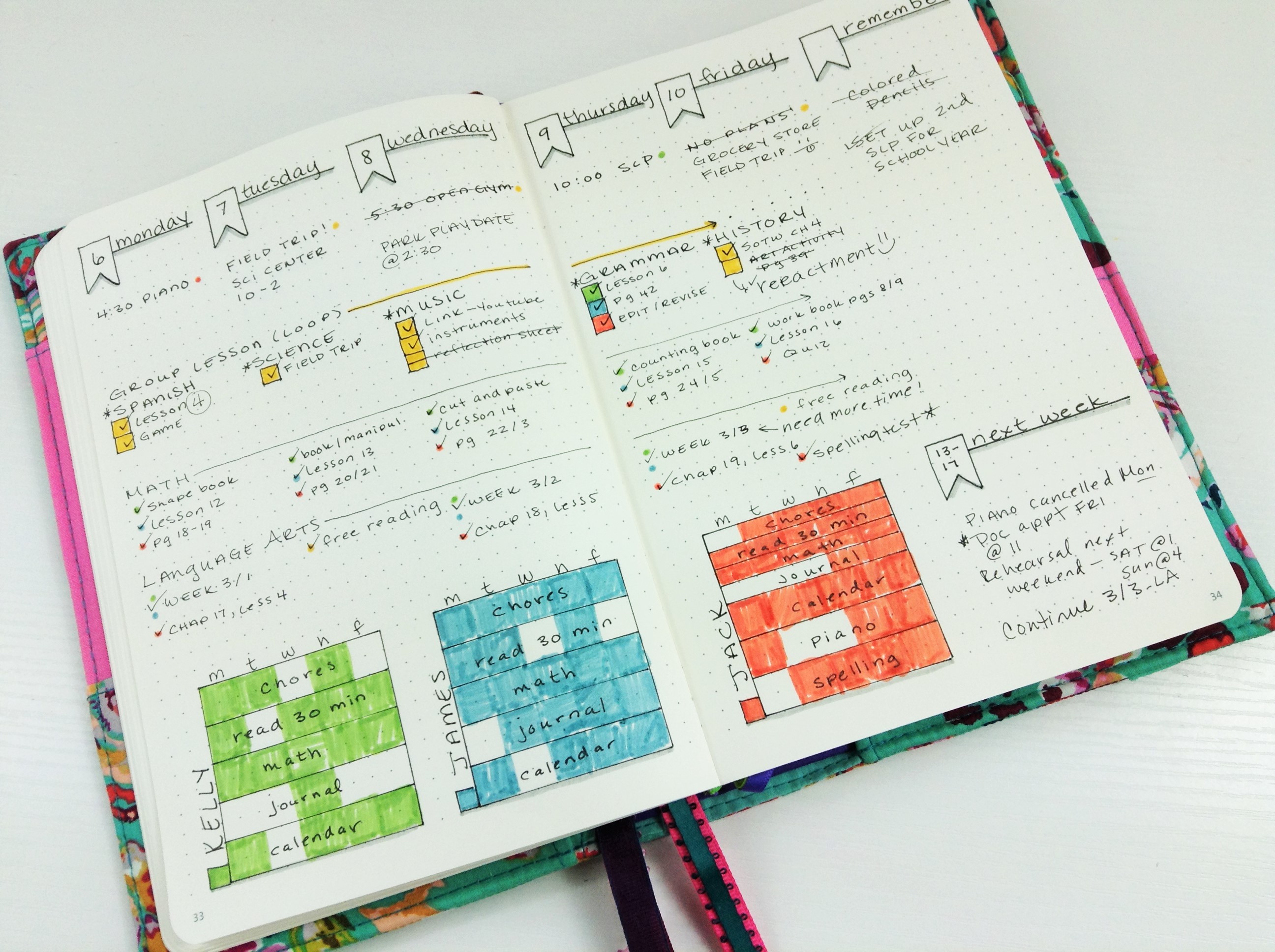
Using Your Homeschool Bullet Journal
If you’re interested in learning more about the bullet journal system, check out the original creator’s site at BulletJournal.com. You will see a more detailed system for how to lay out your entire journal – annually, monthly, weekly, and daily.
But your homeschool bullet journal can be a little more flexible and can be a lot more fun that the original system!
So before you get to drawing, noting, and planning, I want to give you one final tip:
The Key to Staying Organized:
I’ve heard it many times, “I know how to get organized, but I can’t stay organized.” The key is to enjoy the habit of organization.
If a homeschool bullet journal gets you excited and looking at these layouts feels inspiring, then make time in your day every day to revel in your new habit of organization. Love on it. This bullet journal is something you are creating for you and your children. One place to keep order in the chaos of life. It’s your new home base.
On the other hand, if reading through the tips and tricks seems completely overwhelming, try an alternative.
The biggest obstacles I’ve heard over and over when people try bullet journaling is that (1) it’s too time consuming and (2) they don’t like drawing the lines (or don’t think they are any good at it). If that’s the case for you, don’t force it. Try and alternative to straight bullet journaling: find printable bullet journal templates and layouts here.
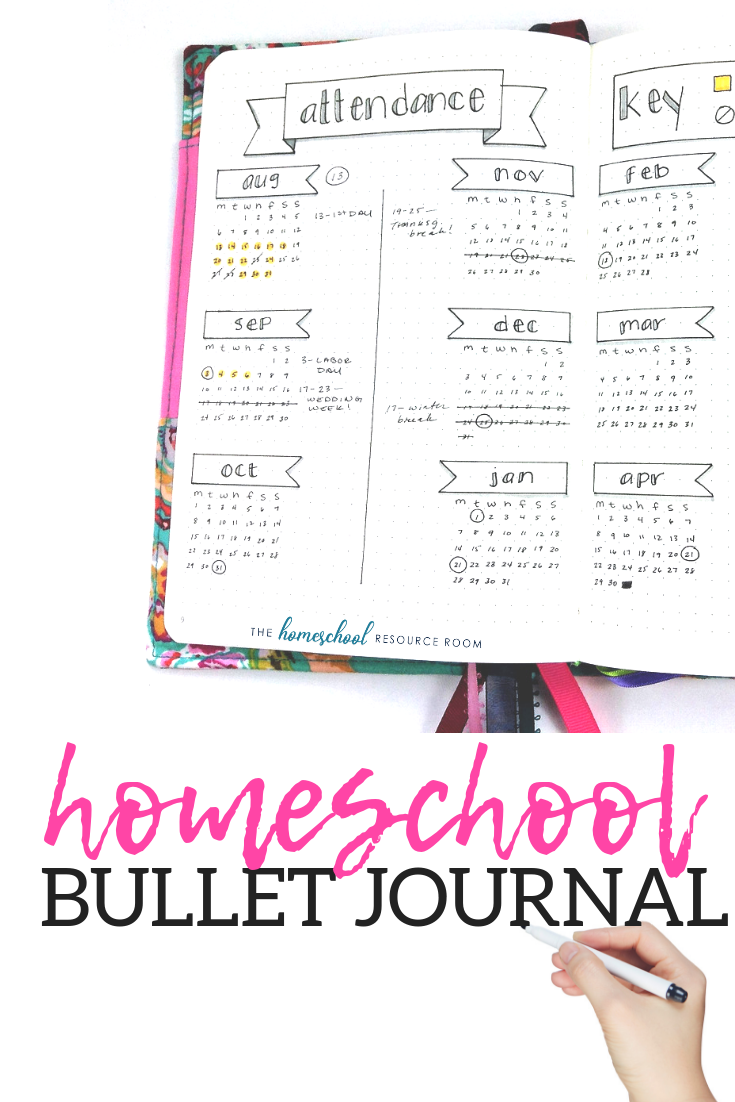
More homeschool planning from the Resource Room:

Ashley helps parents who want to homeschool find the resources they need to successfully teach their children. Ashley is a former teacher, current homeschooler, published author, and designer behind Circle Time with Miss Fox printables as well as the creator of this website, The Homeschool Resource Room.

Hi, You’ve super-inspired me! I just got a B5 sized bujo and ordered a Woodland Farms cover with 10 ribbons and some Staedtler markers— can’t wait!!! (How long did it take to get your cover?) I got it for next school year so I’ve got plenty of time to get it all figured out. Thanks for the great post!!!
Aw that’s fantastic! I’m so excited for you! I got mine at a conference a few years ago, so I’m not sure about how long it takes for delivery, sorry. But yes lots of time to get it set up! Thanks for your comment, you made my day!